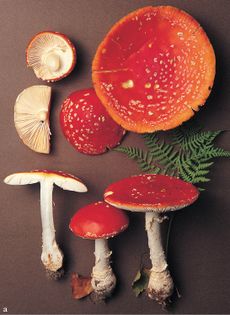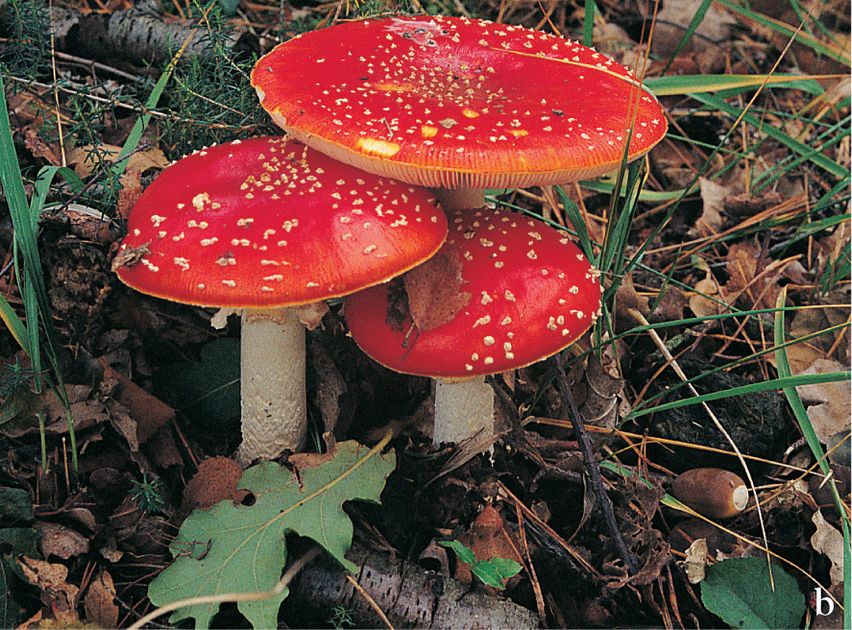Fly Agaric Amanita muscaria (L.) Pers. (illustrated (a) 40% life size) Cap 8–20cm across, globose or hemispherical at first, then flattening; bright scarlet, covered with distinctive pyramidal, white warts, which may be washed off by rain, leaving the cap almost smooth and the colour faded. Stem 80–180×10–20mm with a bulbous base; white, with the white, membranous ring attached to the stem apex sometimes becoming flushed yellow from the pigment washed off the cap; often covered in shaggy volval remnants, as is the base. Flesh white, tinged red or yellow below the cap cuticle; taste pleasant, smell faint. Gills free; white. Spores 9.5–10.5×7–8¼, broadly ovate; nonamyloid. Spore print white. Habitat usually with birch trees; late summer to late autumn. Very common. Poisonous. Note this is one of the easiest species to recognize and describe, and consequently its properties have been well documented for centuries. The common name Fly Agaric comes from the practice of breaking the cap into platefuls of milk, used since medieval times to stupefy flies. It is a strong hallucinogen and intoxicant, and is used as such by the Sami of northern Scandinavia. In such cases the cap is dried and swallowed without chewing, and the symptoms begin twenty minutes to two hours after ingestion. The central nervous system is affected, and the muscles of the intoxicated person start to pull and twitch convulsively. This is followed by dizziness and a deathlike sleep; during this stage the mushrooms are often vomited, but the stupor and drunkenness continue. While in this state of stupor, the person experiences vivid visions, and on waking is usually filled with elation and is physically very active. This is due to the nerves being highly stimulated, the slightest effort of will producing exaggerated physical effects; for example, the intoxicated person will make a gigantic leap to clear the smallest obstacle. The Sami may have picked up the habit of eating the Fly Agaric through observing the effects of the fungus on reindeer, which are similarly affected. Indeed, reindeer like it so much that all one has to do to round up a wandering herd is to scatter pieces of Fly Agaric on the ground. Another observation the Sami made from the reindeer was that the intoxicating compounds can be recycled by consuming the urine of an intoxicated person. The effects of this species are exceedingly unpredictable; some people remain unaffected while others have similar, or different, symptoms to those above, and at least one death is attributed to A. muscaria. This unpredictability is due to the fungus containing different amounts of the toxins ibotenic acid and muscimol according to season and the method of cooking and ingestion, as well as the subject’s state of mind. Ibotenic acid is mostly concentrated in the coloured skin of the cap. This very unstable compound rapidly degrades on drying to form muscimol, which is five to ten times more potent. This is an extremely dangerous fungus to ingest, even in small amounts, and should always be treated as deadly poisonous.




